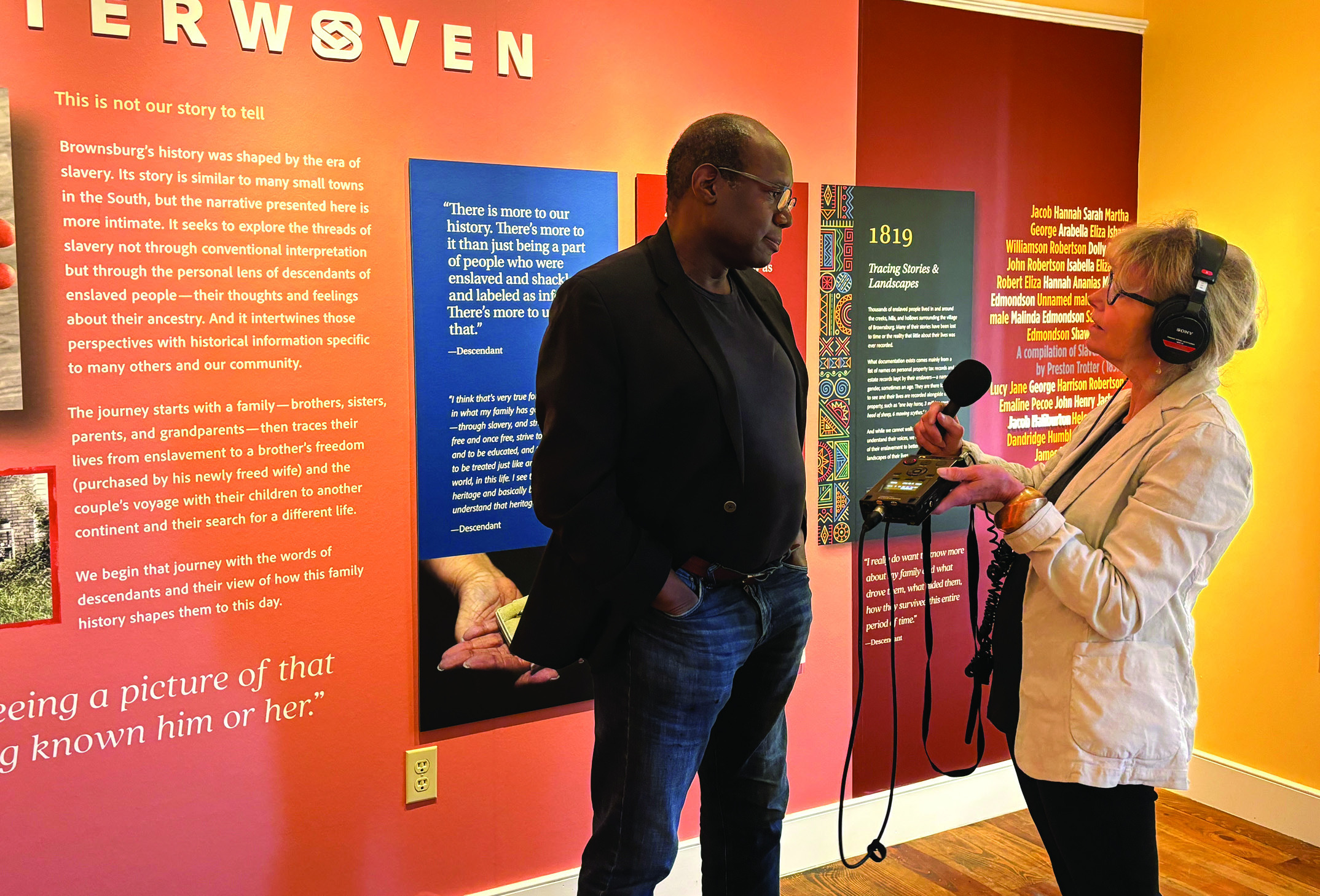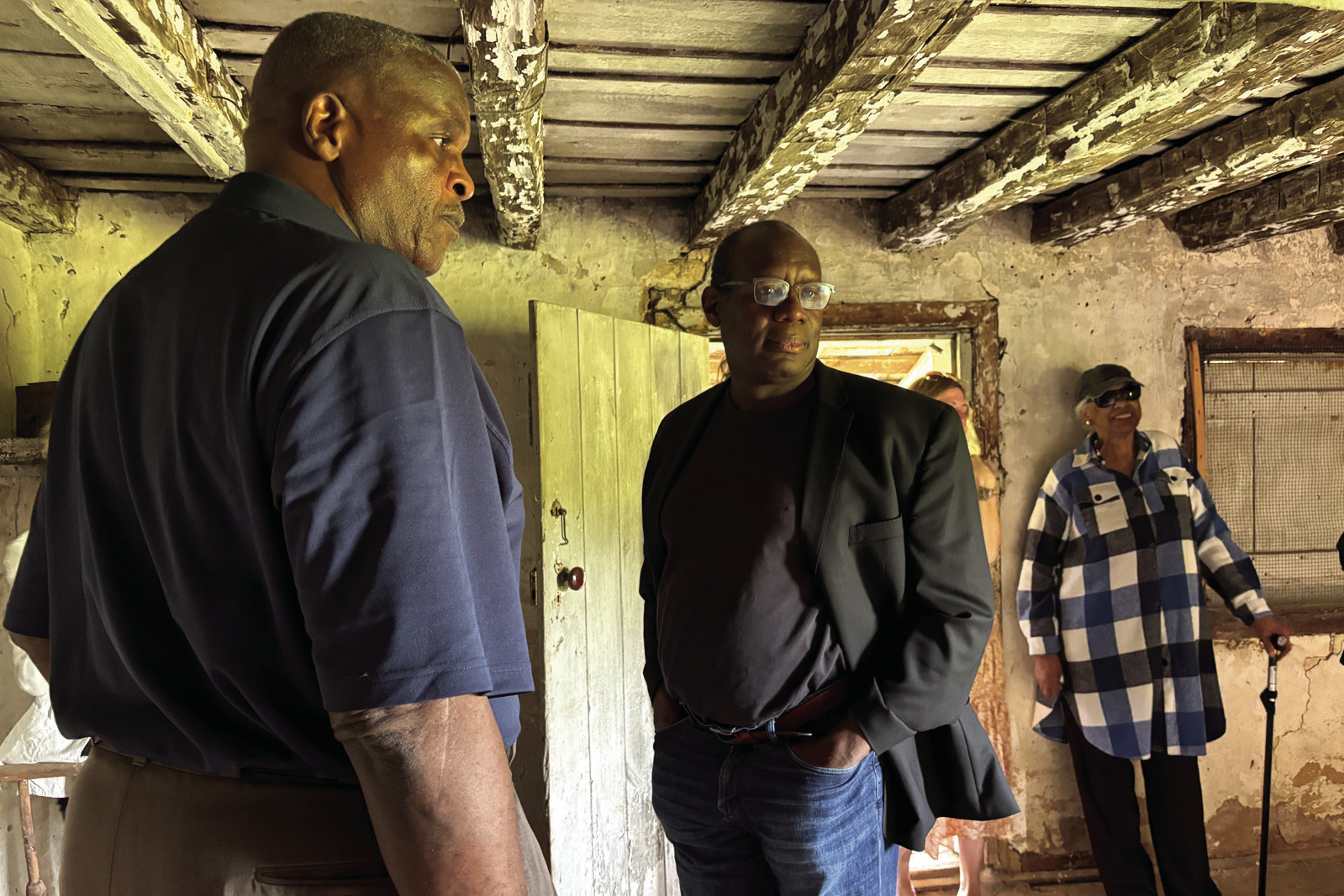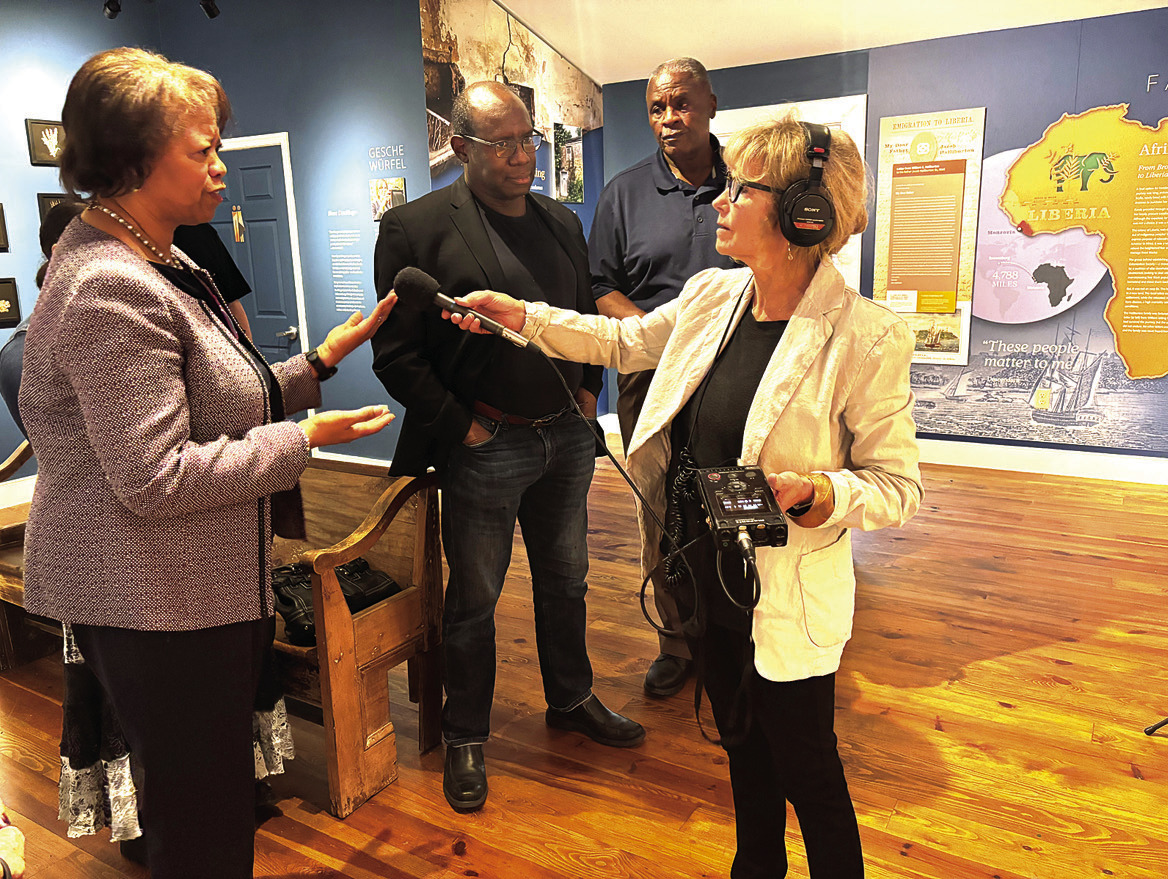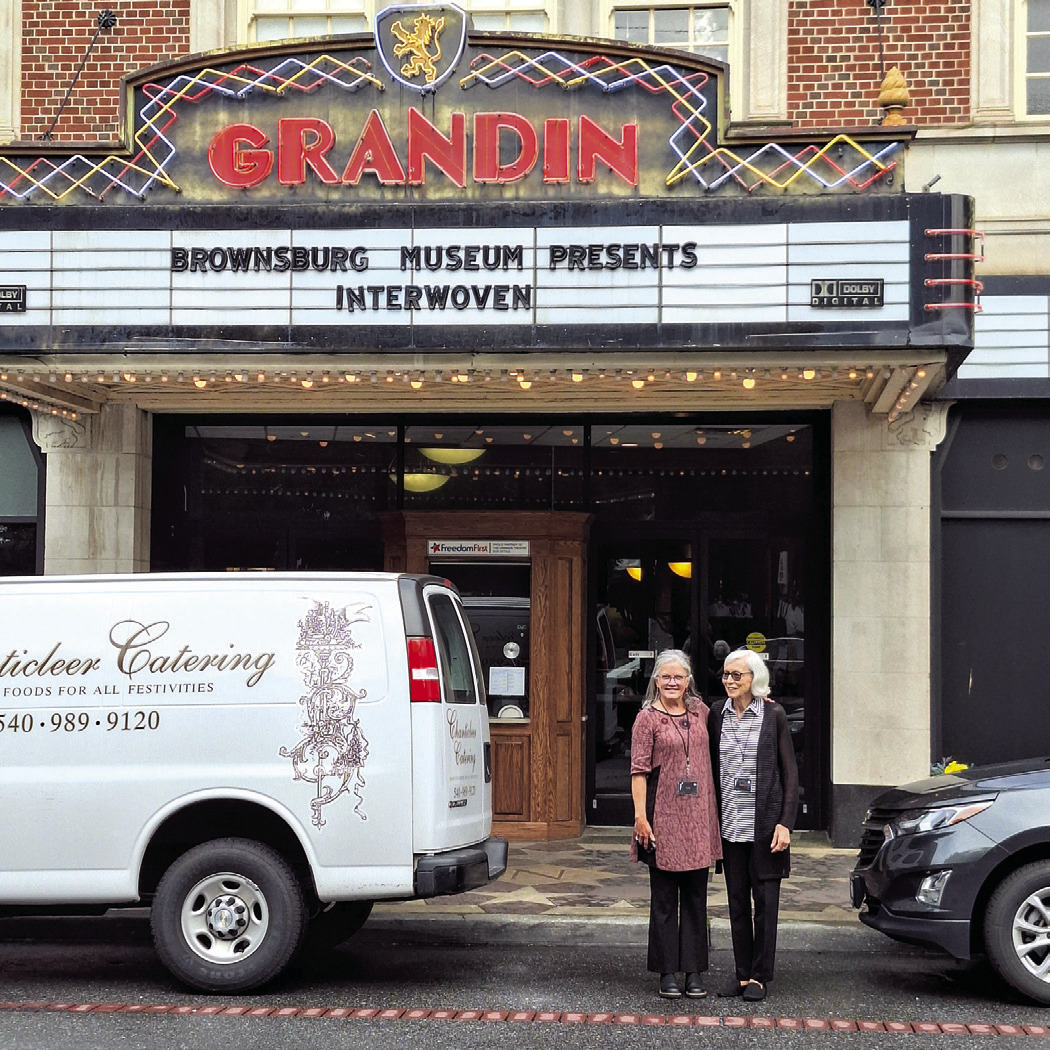NPR Reporter Brings ‘Interwoven’ To National Audience
How does a two-room museum in a small historic village reach nearly five million people?
Through serendipity and by the way that most news travels in rural areas - through word of mouth, then ultimately on the radio. This is precisely how the Brownsburg Museum and its new exhibit, “Interwoven: Unearthed Stories of Slavery,” ended up being featured on the national radio program “Here and Now.”
Robin Young, an award-winning journalist and host of WBUR’s Boston Public Radio, traveled to Brownsburg in May to spend the day interviewing and recording conversations with museum volunteers and descendants who worked together to develop the exhibit about the enslaved Haliburton family.

ROBIN YOUNG, journalist from public radio’s “Here & Now” program, interviews David Green in the front room of the Brownsburg Museum where “Interwoven: Unearthed Stories of Slavery” is now on display. (Mary Woodson photo)
It all started with a family visit to the Valley. Julie Fox, chair of the museum board, hosted her sister, Amy Macdonald, who lives in Boston, at her home near Brownsburg.
Macdonald, currently working as the director of WBUR City Space, had been hearing about the “Interwoven” exhibit for months. During a visit last fall, she was able to view some of the preliminary designs for the museum walls. While peering at the initial designs on a computer, she was struck by the quality of the work and impressed by the fact that a small local volunteer museum would tackle such a complex yet important topic.
“This story feels like the little engine that could,” Macdonald told her sister. “This small place is telling the story of slavery uniquely and powerfully,” she commented.
She knew at the time this story would make a great public radio segment. So she stayed in touch about the exhibit’s progress, and when the doors opened in March, Macdonald pitched the idea of doing a radio segment to one of her colleagues, host Robin Young.
What most captivated the radio journalist, she would later explain, was the unique way the history of slavery in Brownsburg was told — through the lens of firstperson conversations with descendants. With her recording gear packed, she was ready for a journey out of state and back in time. -As the airplane wheels touched down in Richmond, descendants gathered in Brownsburg for the afternoon interview session at the museum. While Halliburton descendants Betty Warren of Maryland and David Green of Charlottesville, and Betty Brown of Brownsburg, had seen the exhibit when it opened, Stan Land, from Texas, had not. So, he and Young saw the exhibit for the first time together.
“I’m your paparazzi!” she said to Land as she readied her microphone and recorder just outside to capture that moment before they entered the building. Exhibit writer and story developer Dee Papit began to walk the visitors through the exhibit, noting the conversations that she and Land had exchanged over the months of development and finding the places within the exhibit where they had worked together to gather information.
“Remember when you sent this picture to me?” she asked.
“I do indeed,” he replied. It was a moment where the time and distance between collaborators faded, and the faces of people from the past joined them to all be together in the same place. It would be the first of many emotional moments on a day that would reveal how strangers can become friends when they purposefully delve into the past together.
Young’s questions were methodical, as expected from an experienced journalist, yet sensitive to what was unfolding in the room around her.
As the group moved through the exhibit, Young probed with gentle but pointed questions. “What’s the impact on you to see it?”
As the narrator, she described the exhibit in ways that ultimately brought the listener into the space with her when the segment is broadcast. “The walls are covered with bills of sale for enslaved people, inventories with names listed as assets along with sheep, cows, and furniture,” she recorded.
Then she led the interviewees to the heart of the exhibit, a letter on loan from Washington and Lee’s Special Collections. It’s from William Haliburton to his father, Jacob. And, it was a poignant moment in the interview when Stan saw the letter for the first time. “It just smacks you in the face,” he told Young while struggling to hold his composure.
“Why do you think people didn’t talk about slavery?” Young asked Betty Brown of Brownsburg. “That’s a big question,” Brown replied. “Nobody talked, we just got along,” she finished as her voice trailed off.
The interview session concluded at the location of a former slave dwelling just outside of Brownsburg.
“This is a pilgrimage,” Young explained to listeners as the museum volunteers and descendants visited the house together. “We’ve stepped back in time and into a reverent place.”
Finally, the sound of car doors shutting and the crunch of wheels on gravel signals the end of a single day in a tworoom museum that brought so many people together, both in the past and in the present. -The Brownsburg Museum segment on the radio show, which has a listening audience of over five million, aired on Tuesday, June 4, and it remained one of the most popular segments for days afterward. Hits on the museum segment on the station’s website reached over one million within the first week.
The segment can still be heard in the archives section of “Here and Now,” and at the link www.wbur.org/hereandnow/ 2024/06/04/slavery-history- virginia-museum. -The interest and excitement of this exhibit are not just for national radio programs.
Its popularity has been countywide. Rockbridge area school groups have visited the exhibit, as well as a spring term class from Washington and Lee.
“The story is powerful, but it’s also educational and the kind of exhibit designed, both in graphics and content, to share information that most did not know about the area and slavery. The story is accessible and visually stunning,” said Fox, “So, it appeals to young groups, older students, and regular museum visitors, alike.”
Members of the Brownsburg Museum board also took a road trip to Roanoke to share the work of the exhibit at an event they sponsored at the Grandin Theater. The event was organized by museum board member Harry Shannon, who wanted to spread the word about the new exhibit and encourage tourism to Rockbridge with area business leaders. -“Never underestimate the impact two rooms can have on the larger world,” said Papit. “These small museums are critical to the communities they serve. They tell our local history in a way larger city museums could never do. And, no matter the difficulty of the story, they can bring us together through our shared past. Besides, to think that millions got to hear about the exhibit and about Brownsburg on the radio is just incredible!”
-The “Interwoven” exhibit can be seen at the Brownsburg Museum on Saturdays, 10 a.m. until 4 p.m., and Sundays, 1 to 4 p.m. Admission is free. The museum is located in the center of the village at 2716 Brownsburg Turnpike. For more information, call (540) 348-1600, or visit www. thebrownsburgmuseum.org.

DESCENDANTS Stan Land, David Green and Betty Brown share a poignant moment inside a slave dwelling near Brownsburg during their visit there with NPR journalist Robin Young. (Mary Woodson photo)

ROBIN YOUNG (right) interviews descendants at the Brownsburg Museum. Pictured are Betty Warren, David Green and Stan Land. (Mary Woodson photo)

JULIE FOX and Nancy Hahn, Brownsburg Museum board members, gather outside the Grandin Theater in Roanoke, where they talked about the “Interwoven” exhibit in May.
.jpg)


